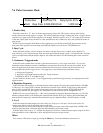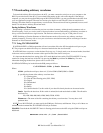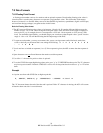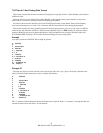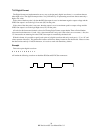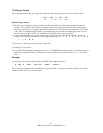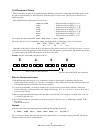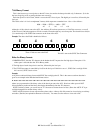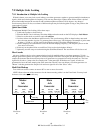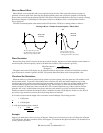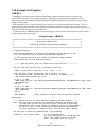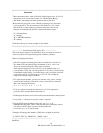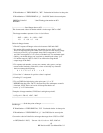
BK Precision 4071 User Manual Rev.2.2
58
7.8.5 Hexadecimal Format
This format sends the same two's complement data that Binary format uses, except that each nibble (4 bits) of the
hex value is represented by an ASCII character. Each data point is a 16-bit value, which is sent to the 4071 as 4
ASCII characters.
Each ASCII character represents 4 bits as follows:
0000 to 1001 - Represented by an ASCII "0" to "9"
1010 - Represented by an ASCII "a" or "A"
1011 - Represented by an ASCII "b" or "B"
1100 - Represented by an ASCII "c" or "C"
1101 - Represented by an ASCII "d" or "D"
1110 - Represented by an ASCII "e" or "E"
1111 - Represented by an ASCII "f" or "F"
For example, the 16 bit value 1101 0011 0101 1111 is sent as "d35f"
The 16 bit value is in "two's complement" format, which represents a number from -1.0 to +1.0 as follows:
8000 ---- E000 ---- FFFF,0 ---- 4000 ---- 7FFF
-1.0 -.5 0.0 +.5 +1.0
Although a 16 bit value is sent to the 4071, the Arbitrary Waveform system uses a 12 bit D/A converter, so not all
16 bits are used. Only the uppermost 12 bits are used to form the arbitrary waveform point. The fourth lowest bit (bit
3) is sent directly to the SYNC Out connector on the front of the 4071.
Example: The data value E468 is handled as follows:
1
1
1
0
E
0
1
0
0
0
1
1
0
1
0
0
0
4 6 8
These 12 bits are sent to the DAC
This bit is sent to the SYNC Out Connector
Rules for Hexadecimal format:
1. Each Hexadecimal value may have 1 to 4 characters. Negative values require 4 characters since the most
significant bit of the value (bit 15) must be a 1 for negative values. If there are fewer than 4 characters the value
is interpreted as positive. Characters are not case sensitive.
2. To separate each number, you may use commas, tabs, spaces, carriage returns and/or linefeeds, semicolons,
colons or basically any character that is not among the following: 0 1 2 3 4 5 6 7 8 9 a A b B c
C d D e E f F X
3. The most significant nibble character is the first that is sent to the 4071. For example, to send the value 1234, the
1 is sent first, then the 2, etc.
4. The SYNC Out output is controlled by bit #3 in the low byte. If this bit is set to 1, SYNC Out is set high. If this
bit is set to
0, SYNC Out is set low.
Example
A 10 points waveform in hexadecimal format with SYNC Out set high on point #3:
0, 4000, fed8 4570 8000 fff0 E6D0, 10 F0,C06 x
The “x” character denotes the end of the data and is optional. If the “x” character is missing, the 4071 will assume
all data has been sent after 1 second timeout.




